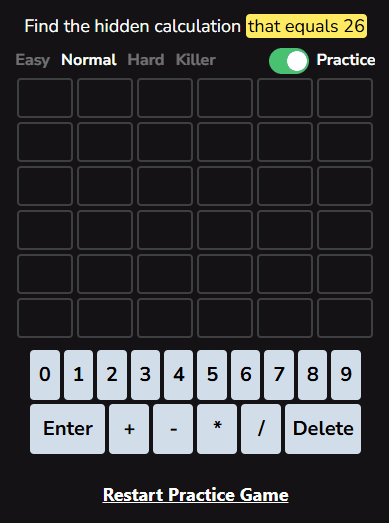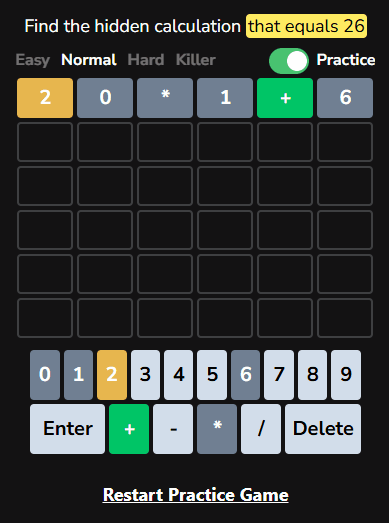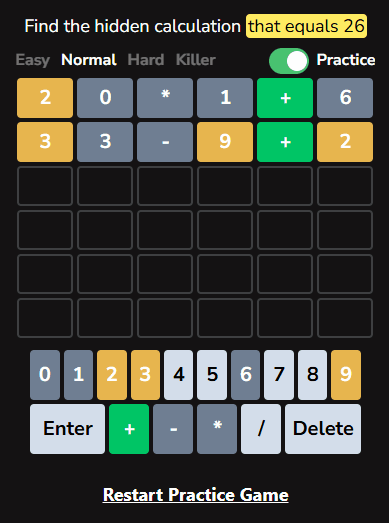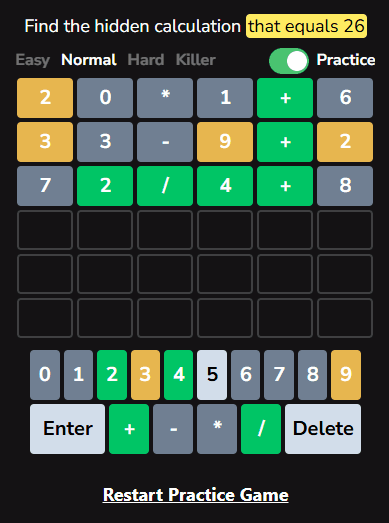How to Solve Mathler (Beginner to Pro in 5 Steps)

Becoming a skilled puzzle solver, especially with a daily math puzzle like Mathler, can be seemingly daunting, but it's actually simple once you get the hang of it. There are many ways to approach a Mathler puzzle, and different ways to arrive at an answer, but there are general practices that can be applied by everyone to help them win the game.
Learn how to solve Mathler and become an expert by following these five steps!
What is Mathler?
Mathler is a math-based game inspired by Wordle®, and your goal is to create an equation that will hit a certain result in six tries. However, unlike Wordle, you get the answer in advance and what you have to do is input the exact solution that will lead to it.
Mathler also has different difficulty settings, and each level has its own number of expression slots (boxes where you input your entries), operations and such.
Quick rules refresher
To become a skilled Mathler solver, it's important to remember the rules involved in math and the game itself:
Only valid answers are accepted
If you input something that won't result in the given, the system won't accept it and it'll pop a prompt. This is to prevent people from brute-forcing the color-feedback system by inputting all operations or numbers in an entry.
Color-feedback system
As a number puzzle that uses arithmetic as a base, it revolves around using digits and operations to guess the right equation. It uses a color-feedback system to help you determine which numbers and operations go where. The color-feedback system is as follows:
| Color | Meaning | Example |
|---|---|---|
| Green | Correct character in the correct position | 2 is green in 2+3=5 if the first slot must be 2 |
| Yellow | Character is in the equation, but in a different position | + is yellow if the plus sign belongs elsewhere |
| Gray | Character is not in the equation | 7 is gray when no 7 appears at all |
Duplicates exist
There will be instances that numbers and operations will appear in the solution multiple times, such as 2+2+2, 10*10*10 or 5*2/5. Duplicates will be marked by the color-feedback system accordingly, like if there are only two duplicates of 5 in the equation, if you input three 5s, then only two will turn green or yellow and the last one will turn gray. This is also the same for operations.
Remember the order of operations (PEMDAS)
This is probably the most important rule to remember—the order of operations. To refresh your memory, PEMDAS stands for Parentheses, Exponents, Multiplication/Division, Addition/Subtraction. When you create an equation, the system will follow this order of operations and determine if your answer is valid.
Another thing to remember is that Multiplication/Division and Addition/Subtraction technically happen at the same time, but must be done in order of left to right. For example:
8*6/3+2-4=?
48/3+2-4=?
16+2-4=?
18-4=14
Invalid answers will pop a prompt telling you that there is an error in your submission, and this is actually where a lot of people make mistakes in their solving. Fortunately, invalid answers won't be accepted by the system, so you won't waste a guess on a mistaken solution.
The 5-step Mathler method
Now to the fun part! We'll be discussing the general steps you can take for any Mathler puzzle to arrive at the answer and win. Keep in mind, these are generalized practices that are meant to help you find your own solving style and provide you with a way of molding your own skills.
- Open strong: try a high-information guess with varied digits and 2 operators to trigger PEMDAS.
- Read constraints: green = lock, yellow = move, gray = exclude (watch duplicates).
- Use math logic: check factors/divisibility and other logically sound ways to prune options.
- Build valid expressions: respect PEMDAS; swap operator order to learn more.
- Finish smart: pick guesses that satisfy existing constraints and avoid wasted guesses—result in a win!
Step 1: Open strong, get info
Like popular daily word puzzles, information gathering is key when trying to solve a Mathler puzzle. In all difficulties, a good opening guess easily makes or breaks a run, so learning how to create a good starting solution filled with info is key.
To illustrate, let’s use a Normal/Classic puzzle with a target number of 26. What counts as a high-information opening guess?
- Use diverse digits (broad 0–9 coverage), two operators, and a structure that triggers PEMDAS.
- Aim to test
+,−,×,÷early (or at least two of them).
Remember, opening guesses aren't meant to hit the answer in one go. They're meant to eliminate numbers and operations. With these in mind, let's start off with this guess:

Why this input?
- It uses a wide spread of non-repeating digits.
- It includes two operators to force more informative feedback.
High-Information Starter Guesses
| Template | What it tests | When to use | Example |
|---|---|---|---|
a + b × c |
PEMDAS interaction; checks + and × |
Classic/Extreme to probe multiplication early | 4+5×3 |
a × b + c |
Product scale + single addition; 3 distinct digits | When target looks mid/high | 6×3+2 |
ab − c × d |
Two operators; subtraction vs multiplication | If early tiles suggest − |
12−3×2 |
Step 2: Read feedback as constraints
Now that we've eliminated a bit of numbers and operations, we take into account the results of the color feedback. That green + is a great hit, and that yellow 2 is also good, but we're still missing four more inputs.
And since we already know which numbers and operations aren't in the equation because of the gray feedback, we can make another educated guess to eliminate even more:

Step 3: Use math logic to prune the possibilities
With our second guess, even more things are made clear. We now have three yellow tiles and one green one, and now we only have to determine two more expression slots. Using math logic and the color feedback, these are the facts we can work with:
- The result is 26, an even number.
- The guaranteed operations in this equation are division and addition, in that order.
- We got three confirmed numbers in the equation; we just have to know where they fit.
- There are four more numbers remaining to be eliminated.
Based on these, you can either;
- Try shuffling the yellow tiles around in a way that will satisfy the logic.
- Solve with algebra using the existing numbers (very hard, as there are no fixed numbers and the only fixed operation is the +).
- Eliminate the remaining numbers.
For now, we'll do what the average non-mathematician would do and try and eliminate the remaining numbers as best we can.
Step 4: Build valid expressions with PEMDAS
Don't forget the order of operations for your inputs. Every guess you make must follow the PEMDAS rule, and it is essential for arranging your equations properly and avoiding wasting guesses. Fortunately, with what we have here, only division and addition are to be used. Let's make another guess now:

Yahtzee! You just love to see those greens pop out! Now that we've already determined fixed and correct numbers/operations, this puzzle is as good as done, and we enter the endgame.
Step 5: Finish smart and hit the hidden calculation
When you've reached this point, you should have a good idea of what the answer is by now. Endgame optimization is all about using up all existing facts and information and delivering the final blow!
Our last guess made the puzzle light up green on four expression slots and eliminated the last few remaining numbers. Since there are only two remaining slots to fill in, pay attention to what we have left—two yellow tiles. And with simple logic, we already know where to put that yellow 9 and 3.
Let's finish this puzzle off!

We won! See, that wasn't so hard, right?
Hard & Extreme mode tips
These two difficulty settings are exponentially harder than Easy or Normal/Classic Mode. While they are more complex to solve, here are general things to keep in mind to be able to solve them yourself:
- Expect longer expressions, especially with Hard Mode.
- Value of multiplication/division scouting first, as they are more common in these higher difficulties.
- Duplicate operations and numbers are also more common, so information gathering is more vital.
FAQ
Why was my equation rejected?
Usually, an invalid input happens because your solution doesn't follow PEMDAS and results in a different number.
How many tries is considered good?
It depends on the difficulty, but in Normal/Classic Mode, four tries is considered average and three tries or less are considered skilled.
How do I get non-spoiler hints?
Use Practice mode to test ideas without streak risk. The color-feedback system is the only existing hint in the game.
Can I play past puzzles or see previous answers?
Right now, you can't. But we're working on a playable archive, so stay tuned!
Is there a printable version for classrooms?
Definitely! You can click this link for it. We highly recommend it for classroom use.
Play today's Mathler puzzle!
We hope that our step-by-step guide was able to help you become a better Mathler solver! Don't forget to check out our other fun games and join our official Discord server to find other brainy game enthusiasts like you!